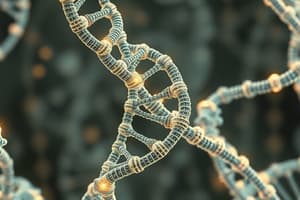Podcast
Questions and Answers
What type of bonds form between adenine and thymine in DNA?
What type of bonds form between adenine and thymine in DNA?
- 4 hydrogen bonds
- 1 hydrogen bond
- 3 hydrogen bonds
- 2 hydrogen bonds (correct)
Which base pairs with guanine in DNA?
Which base pairs with guanine in DNA?
- Cytosine (correct)
- Adenine
- Uracil
- Thymine
What is the structural difference between purines and pyrimidines?
What is the structural difference between purines and pyrimidines?
- Purines are larger and have a double ring structure. (correct)
- Pyrimidines are larger and have a double ring structure.
- Pyrimidines have a double ring structure.
- Purines have a single ring structure.
What is chromatin primarily composed of?
What is chromatin primarily composed of?
What term describes the tightly packed form of chromatin that is inactive?
What term describes the tightly packed form of chromatin that is inactive?
Which type of bond links nucleotides in a single strand of DNA?
Which type of bond links nucleotides in a single strand of DNA?
What is the role of hydrogen bonds in the DNA double helix?
What is the role of hydrogen bonds in the DNA double helix?
Where would euchromatin typically be found?
Where would euchromatin typically be found?
What constitutes the primary structure of DNA?
What constitutes the primary structure of DNA?
How do the nitrogenous bases pair in the secondary structure of DNA?
How do the nitrogenous bases pair in the secondary structure of DNA?
What forms the sugar-phosphate backbone in the primary structure of DNA?
What forms the sugar-phosphate backbone in the primary structure of DNA?
What describes the tertiary structure of DNA?
What describes the tertiary structure of DNA?
What is the significance of the double helix structure of DNA?
What is the significance of the double helix structure of DNA?
What are nucleosomes in the context of DNA?
What are nucleosomes in the context of DNA?
Which of the following is NOT a component of a nucleotide?
Which of the following is NOT a component of a nucleotide?
During cell division, chromatin condenses into which structures?
During cell division, chromatin condenses into which structures?
Flashcards
DNA Primary Structure
DNA Primary Structure
The simplest level of DNA structure, consisting of the order of nucleotides (A, T, C, G).
DNA Nucleotide
DNA Nucleotide
The building block of DNA, composed of a sugar, phosphate, and a nitrogenous base.
DNA Secondary Structure
DNA Secondary Structure
The double helix structure of DNA, formed by hydrogen bonds between complementary bases (A-T, C-G).
Complementary Base Pairing
Complementary Base Pairing
Signup and view all the flashcards
DNA Tertiary Structure
DNA Tertiary Structure
Signup and view all the flashcards
Histones
Histones
Signup and view all the flashcards
Nucleosomes
Nucleosomes
Signup and view all the flashcards
Chromatin
Chromatin
Signup and view all the flashcards
Base Pairing (DNA)
Base Pairing (DNA)
Signup and view all the flashcards
Purines/Pyrimidines
Purines/Pyrimidines
Signup and view all the flashcards
Hydrogen Bonds (DNA)
Hydrogen Bonds (DNA)
Signup and view all the flashcards
Heterochromatin
Heterochromatin
Signup and view all the flashcards
Phosphodiester Bonds
Phosphodiester Bonds
Signup and view all the flashcards
Study Notes
DNA Structure
- DNA has three levels of structure: primary, secondary, and tertiary.
- Primary structure: The sequence of nucleotides (A, T, C, G). Nucleotides consist of a sugar (deoxyribose), a phosphate group, and a nitrogenous base. Nucleotides link via sugar-phosphate bonds creating a backbone.
- Secondary structure: The double helix formed by hydrogen bonds between complementary base pairs: A-T (2 hydrogen bonds) and G-C (3 hydrogen bonds). The strands run antiparallel, with base pairs forming the "steps" of the helix.
- Tertiary structure: The 3D arrangement of the double helix. DNA wraps around histone proteins to form nucleosomes. Nucleosomes coil further into chromatin, which compacts into chromosomes. This packaging allows DNA to fit within the cell and controls gene accessibility.
Base Pairing
- Adenine (A) pairs with Thymine (T) with 2 hydrogen bonds.
- Guanine (G) pairs with Cytosine (C) with 3 hydrogen bonds.
- G-C bonds are stronger (3 hydrogen bonds) than A-T bonds (2 hydrogen bonds), contributing to the stability of the double helix.
Purines and Pyrimidines
- Purines (A, G) are larger, with a double-ring structure.
- Pyrimidines (C, T, U) are smaller, with a single-ring structure.
- A purine always pairs with a pyrimidine to maintain a consistent DNA helix width.
Chromatin Structure
- Chromatin is the complex of DNA and proteins (mostly histones) that makes up chromosomes.
- DNA coils around histone proteins, forming nucleosomes. These nucleosomes coil further to create chromatin, which further condenses into chromosomes.
Heterochromatin vs. Euchromatin
- Heterochromatin: Tightly packed, darker-staining chromatin. Contains inactive DNA. Found in regions like centromeres and telomeres.
- Euchromatin: Loosely packed, lighter-staining chromatin. Contains active DNA. Found in parts of the chromosome where gene expression is high.
Bonds in DNA
- Phosphodiester bonds: Covalent bonds connecting nucleotides within a single DNA strand to create the sugar-phosphate backbone.
- Hydrogen bonds: Weak bonds connecting complementary base pairs across the two DNA strands to form the double helix.
Studying That Suits You
Use AI to generate personalized quizzes and flashcards to suit your learning preferences.




